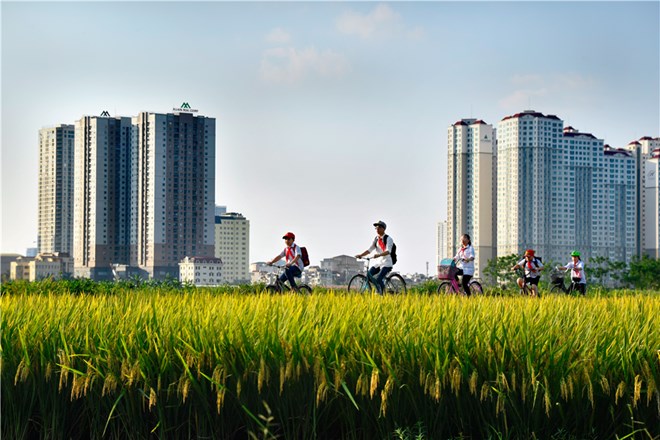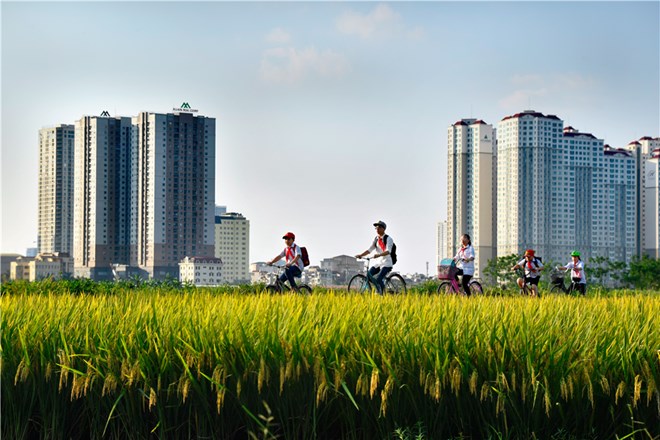
As many as 139 photos depicting the suburban life in Hanoi are being displayed at an exhibition which opened at 45 Trang Tien Street, downtown the capital city on August 3.

A photo on display by Truong The Cau (Source: hanoimoi.com.vn)
The exhibited photos are the winning works of the 48th fine art photography
contest held to celebrate this year’s August Revolution (August 19), National
Day (September 2), the 64th anniversary of Hanoi’s Liberation Day (October 10)
and 10th years of the capital’s boundary expansion.
According to Dao Quang Minh, Vice President of the Hanoi Association of
Photographic Artist and head of the contest’s jury, some 1,750 entries have
been sent to the organizers from 293 photographers since the competition was
launched 2 months ago. Most of the works captured people’s life in four
districts on the outskirts of Hanoi – Dan Phuong, Thanh Tri, Hoai Duc and Dong
Anh which has been recognised as new-style rural districts.
Speaking at the exhibition’s opening ceremony, Deputy Secretary of the
municipal Party Committee Ngo Thi Thanh Hang said a decade after Hanoi’s
boundary expansion, the capital has seen remarkable progress with achievements
recorded in multiple fields, including politics, economy, society, and
culture.
The city’s rural areas have also experienced significant changes, helping Hanoi
lead the country in the new-style rural area building with 76.2 percent of
communes and four districts gaining the status, she noted.
The exhibition is expected to help promote efforts by the administration and
people of Hanoi over the past decade and motivate the better construction of
the city.
Source: VNA
With an increasingly vibrant and widespread emulation movement aimed at building cultured residential areas and cultured families, Yen Thuy District has been making steady progress toward improving both the material and spiritual well-being of its people, while fostering a civilized, prosperous, beautiful, and progressive community.
Once lacking recreational spaces and community facilities, Residential Group 2 in Quynh Lam Ward (Hoa Binh City) has recently received attention for the construction of a new, spacious, and fully equipped cultural house. The project followed the model of state support combined with public contributions in both labor and funding.
The "All people unite to build cultural life" movement, which has been effectively integrated with Kim Boi district’s socio-economic development goals, is fostering a lively spirit of emulation across local residential areas, hamlets, villages, public agencies, and enterprises. In addition, through the initiative, traditional cultural values are being preserved and promoted, while community solidarity and mutual support in poverty reduction and economic development are being strengthened.
A working delegation of the Hoa Binh provincial People’s Committee led by its Permanent Vice Chairman Nguyen Van Toan on June 11 inspected the progress of a project to build the Mo Muong Cultural Heritage Conservation Space linked to tourism services in Hop Phong commune, Cao Phong district.
Born and growing in the heroic land of Muong Dong, Dinh Thi Kieu Dung, a resident in Bo town of Kim Boi district, in her childhood was nurtured by the sweet lullabies of her grandmother and mother. These melodies deeply imprinted on her soul, becoming an inseparable part of her love for her ethnic group's culture. For over 20 years, this love for her hometown has driven Dung to research, collect, and pass down the cultural values of the Muong people to future generations.
In the final days of May, the Ethnic Art Troupe of Hoa Binh Province organized performances to serve the people in remote, mountainous, and particularly disadvantaged areas within the province. These were not just ordinary artistic shows, but they were the meaningful journeys aimed at spreading cultural values, enhancing the spiritual life of the people and contributing to the preservation of ethnic minority cultural identities.



